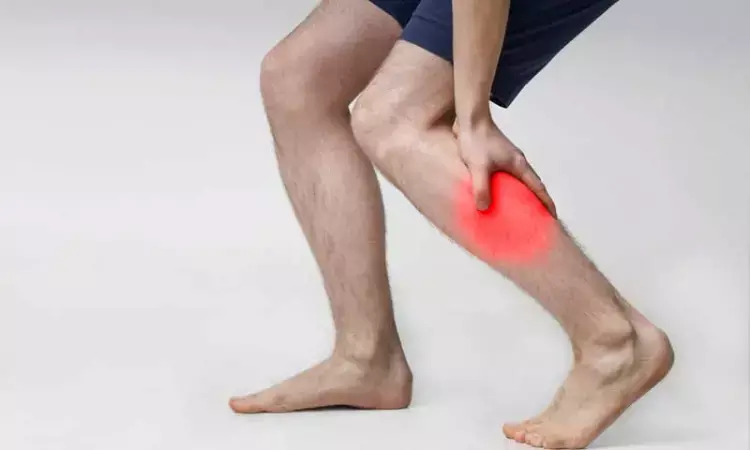- Home
- Medical news & Guidelines
- Anesthesiology
- Cardiology and CTVS
- Critical Care
- Dentistry
- Dermatology
- Diabetes and Endocrinology
- ENT
- Gastroenterology
- Medicine
- Nephrology
- Neurology
- Obstretics-Gynaecology
- Oncology
- Ophthalmology
- Orthopaedics
- Pediatrics-Neonatology
- Psychiatry
- Pulmonology
- Radiology
- Surgery
- Urology
- Laboratory Medicine
- Diet
- Nursing
- Paramedical
- Physiotherapy
- Health news
- Fact Check
- Bone Health Fact Check
- Brain Health Fact Check
- Cancer Related Fact Check
- Child Care Fact Check
- Dental and oral health fact check
- Diabetes and metabolic health fact check
- Diet and Nutrition Fact Check
- Eye and ENT Care Fact Check
- Fitness fact check
- Gut health fact check
- Heart health fact check
- Kidney health fact check
- Medical education fact check
- Men's health fact check
- Respiratory fact check
- Skin and hair care fact check
- Vaccine and Immunization fact check
- Women's health fact check
- AYUSH
- State News
- Andaman and Nicobar Islands
- Andhra Pradesh
- Arunachal Pradesh
- Assam
- Bihar
- Chandigarh
- Chattisgarh
- Dadra and Nagar Haveli
- Daman and Diu
- Delhi
- Goa
- Gujarat
- Haryana
- Himachal Pradesh
- Jammu & Kashmir
- Jharkhand
- Karnataka
- Kerala
- Ladakh
- Lakshadweep
- Madhya Pradesh
- Maharashtra
- Manipur
- Meghalaya
- Mizoram
- Nagaland
- Odisha
- Puducherry
- Punjab
- Rajasthan
- Sikkim
- Tamil Nadu
- Telangana
- Tripura
- Uttar Pradesh
- Uttrakhand
- West Bengal
- Medical Education
- Industry
Atypical Presentation of Diffuse Large B-cell Lymphoma in a Lower Limb Soft Tissue Mass: A Case Report

Family doctors frequently encounter patients with vague and nonspecific symptoms, which are often attributed to common and benign conditions. However, in some cases, they may represent the initial or atypical presentation of serious diseases, including malignancies such as lymphomas. Diffuse large B-cell lymphoma (DLBCL) is the most common subtype of non-Hodgkin lymphoma, accounting for 30-40% of cases. It typically affects older adults and is characterized by rapid clinical progression. While DLBCL often presents with painless lymphadenopathy or systemic B symptoms, up to 30% of patients may exhibit extranodal involvement, affecting sites such as the gastrointestinal tract, CNS, bone, and, rarely, soft tissues and skin.
An 80-year-old male with a history of hypertension and no prior oncologic disease, in good general condition, presented to primary care with pain, swelling, and erythema in the left ankle and lower leg. The patient had no other associated symptoms, such as fever, weight loss, fatigue, night sweats, or palpable lymphadenopathy. The initial impression was bacterial cellulitis, and he was treated with flucloxacillin.
As symptoms persisted, clindamycin was added, and a soft tissue ultrasound with Doppler was performed, revealing a “nodular formation adjacent to the popliteal nerve”, which, at the time, was not definitively characterized as malignant.
One month later, the patient returned to primary care with worsening edema and significant limb enlargement. A CT scan revealed two well-defined soft tissue masses: one in the popliteal region (14 × 8 × 6.5 cm) and another in the distal leg (13 × 7 × 5 cm). Ultrasound-guided biopsy, performed approximately three months after initial presentation, confirmed DLBCL of germinal center origin, and the patient was referred to Hematology. A PET scan revealed widespread lymphadenopathy and two hypermetabolic soft tissue masses in the left leg, and MRI showed “Two solid soft tissue masses suggestive of metastatic nature located in the posterior compartment of the knee, associated with popliteal vein thrombosis, and in the left ankle involving the peroneal region”.
The patient was started on R-CHOP (rituximab, cyclophosphamide, doxorubicin, vincristine, and prednisone) chemotherapy. Re-staging PET showed reduced metabolic activity but increased mass size. Given vascular involvement, surgical resection was not an option. He received palliative radiotherapy, which offered symptomatic relief. Despite second-line chemotherapy, the patient died one year after diagnosis.
The authors concluded – “DLBCL can present atypically as a rapidly enlarging soft tissue mass, mimicking infection, even without systemic symptoms. For soft tissue lesions unresponsive to standard treatments, malignancy must be strongly considered in the differential diagnosis. Timely imaging and biopsy are essential for accurate diagnosis and prompt initiation of therapy. Additionally, early detection can significantly influence treatment decisions, which is especially important for younger and fitter patients who may be candidates for more aggressive alternative therapies. This report underscores the critical importance of clinical vigilance, multidisciplinary collaboration, and maintaining a low threshold for re-evaluation in atypical or persistent soft tissue lesions, particularly in elderly patients.”
Further reading:
The Atypical Presentation of Diffuse Large B-cell Lymphoma in a Lower Limb Soft Tissue Mass: A Case Report
Filipe Leal et al
Cureus 17(6): e86676. DOI 10.7759/cureus.86676
MBBS, Dip. Ortho, DNB ortho, MNAMS
Dr Supreeth D R (MBBS, Dip. Ortho, DNB ortho, MNAMS) is a practicing orthopedician with interest in medical research and publishing articles. He completed MBBS from mysore medical college, dip ortho from Trivandrum medical college and sec. DNB from Manipal Hospital, Bengaluru. He has expirence of 7years in the field of orthopedics. He has presented scientific papers & posters in various state, national and international conferences. His interest in writing articles lead the way to join medical dialogues. He can be contacted at editorial@medicaldialogues.in.


